



Season | Archery |
|---|---|
Start and end date | Sept. 7 to Oct. 20 |
Season | Youth (deer only) |
Start and end date | Oct. 17-18 |
Season | General |
Start and end date | Oct. 26 to Dec. 1 |
Season | Shoulder season (elk) |
Start and end date | Aug. 15 to Feb. 15 |
Season | Start and end date |
|---|---|
Archery | Sept. 7 to Oct. 20 |
Youth (deer only) | Oct. 17-18 |
General | Oct. 26 to Dec. 1 |
Shoulder season (elk) | Aug. 15 to Feb. 15 |
Season | Archery |
|---|---|
Start and end date | Sept. 7 to Sep. 14 |
Season | General |
Start and end date | Sept. 15 to Dec. 1 |
Season | Start and end date |
|---|---|
Archery | Sept. 7 to Sep. 14 |
General | Sept. 15 to Dec. 1 |
Item | Conservation license |
|---|---|
Cost | $8 |
Item | General deer license |
Cost | $16 |
Item | Deer permit application fee(nonrefundable) |
Cost | $5 |
Item | Bonus point fee |
Cost | $2 |
Item | Total |
Cost | $31 |
Item | Cost |
|---|---|
Conservation license | $8 |
General deer license | $16 |
Deer permit application fee(nonrefundable) | $5 |
Bonus point fee | $2 |
Total | $31 |
Item | Big Game Combination (deer and elk license) |
|---|---|
Cost | $1,065 |
Item | Elk Combination (elk license only) |
Cost | $905 |
Item | Deer Combination (deer license only) |
Cost | $639 |
Item | Preference point (optional) |
Cost | $50 |
Item | Cost |
|---|---|
Big Game Combination (deer and elk license) | $1,065 |
Elk Combination (elk license only) | $905 |
Deer Combination (deer license only) | $639 |
Preference point (optional) | $50 |
Item | Deer permit application fee (nonrefundable) |
|---|---|
Cost | $5 |
Item | Bow and arrow license(if applying for an archery only hunt) |
Cost | $10 |
Item | Bonus point |
Cost | $20 |
Item | Total cost if applying with Big Game Combination |
Cost | $1,100 |
Item | Total cost if applying with Deer Combination |
Cost | $674 |
Item | Cost |
|---|---|
Deer permit application fee (nonrefundable) | $5 |
Bow and arrow license(if applying for an archery only hunt) | $10 |
Bonus point | $20 |
Total cost if applying with Big Game Combination | $1,100 |
Total cost if applying with Deer Combination | $674 |
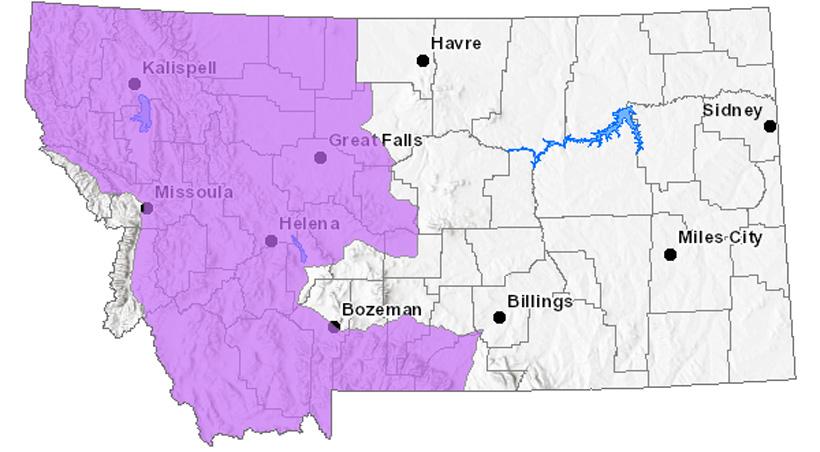
Source: Montana Field Guide
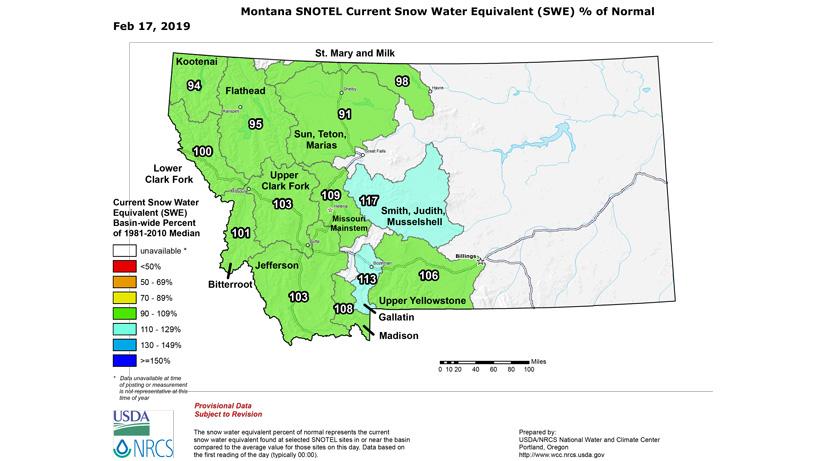
2019 Montana snow water equivalent update as of February 17, 2019. Source: National Resources Conservation Service
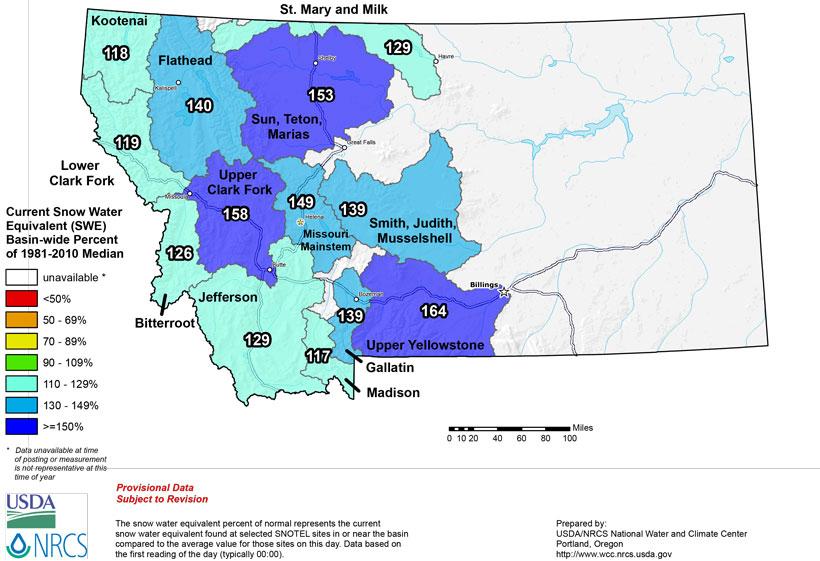

Source: Montana Fish, Wildlife and Parks
Number of points | 0 |
|---|---|
Applicants | 7,747 |
Numbersuccessful | 3,970 |
Drawodds | 51.25% |
Number of points | 1 |
Applicants | 9,007 |
Numbersuccessful | 9,007 |
Drawodds | 100% |
Number of points | 2 |
Applicants | 708 |
Numbersuccessful | 708 |
Drawodds | 100% |
Number of points | 3 |
Applicants | 3 |
Numbersuccessful | 3 |
Drawodds | 100% |
Number of points | Applicants | Numbersuccessful | Drawodds |
|---|---|---|---|
0 | 7,747 | 3,970 | 51.25% |
1 | 9,007 | 9,007 | 100% |
2 | 708 | 708 | 100% |
3 | 3 | 3 | 100% |
Number of points | 0 |
|---|---|
Applicants | 2,690 |
Numbersuccessful | 1,443 |
Drawodds | 53.64% |
Number of points | 1 |
Applicants | 1,827 |
Numbersuccessful | 1,827 |
Drawodds | 100% |
Number of points | 2 |
Applicants | 75 |
Numbersuccessful | 75 |
Drawodds | 100% |
Number of points | Applicants | Numbersuccessful | Drawodds |
|---|---|---|---|
0 | 2,690 | 1,443 | 53.64% |
1 | 1,827 | 1,827 | 100% |
2 | 75 | 75 | 100% |
Number of points | 0 |
|---|---|
Applicants | 7,614 |
Numbersuccessful | 4,577 |
Drawodds | 60.11% |
Number of points | 1 |
Applicants | 4,117 |
Numbersuccessful | 4,117 |
Drawodds | 100% |
Number of points | 2 |
Applicants | 282 |
Numbersuccessful | 282 |
Drawodds | 100% |
Number of points | 3 |
Applicants | 4 |
Numbersuccessful | 4 |
Drawodds | 100% |
Number of points | Applicants | Numbersuccessful | Drawodds |
|---|---|---|---|
0 | 7,614 | 4,577 | 60.11% |
1 | 4,117 | 4,117 | 100% |
2 | 282 | 282 | 100% |
3 | 4 | 4 | 100% |
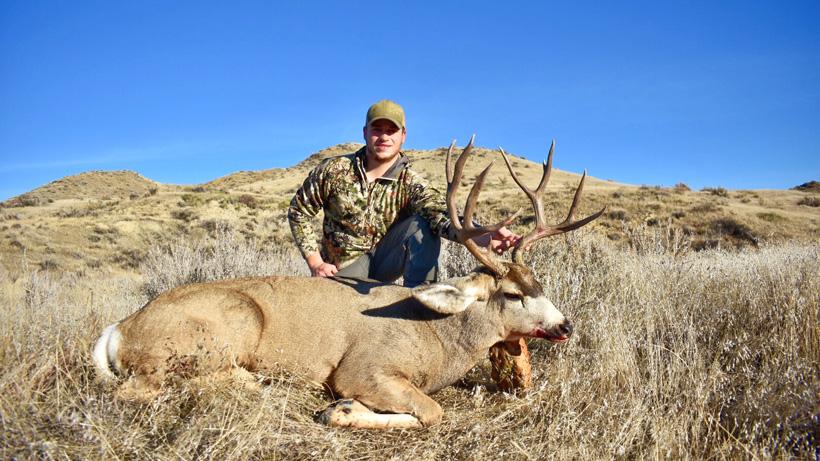
Dylan Downson with his 2018 Montana mule deer.

Source: Montana Fish, Wildlife and Parks
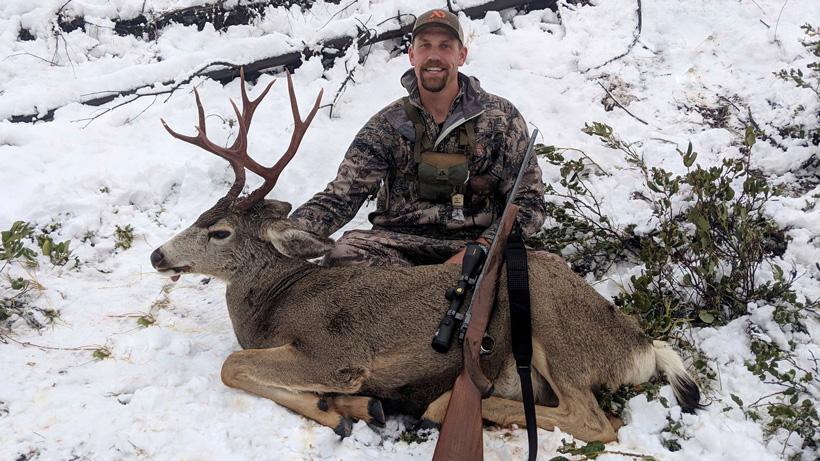
Josh Volinkaty with his 2018 Montana mule deer.

Calvin Connor with his 2018 general season Montana mule deer.
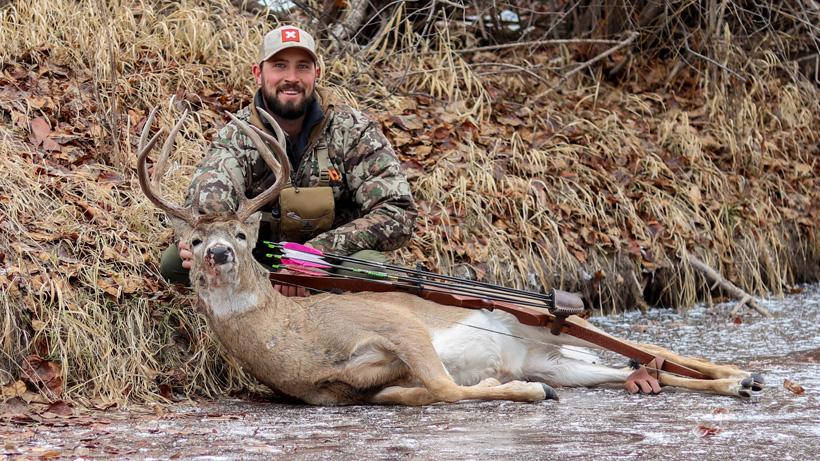
Rex Wolferman with his 2018 Montana archery whitetail deer.
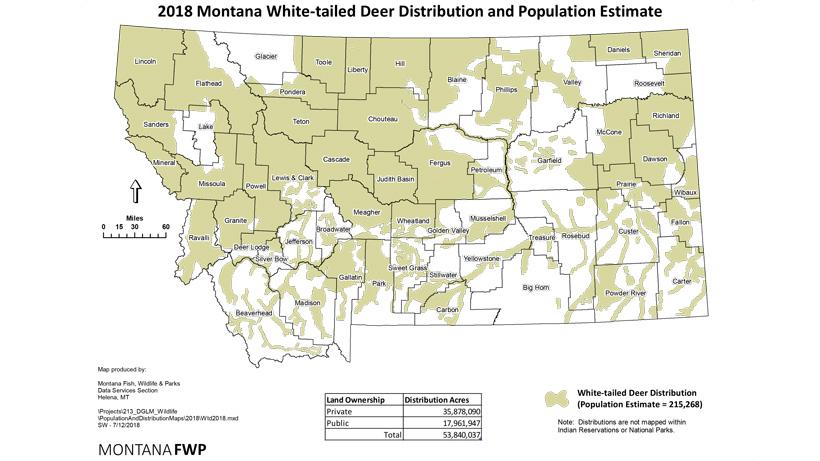
Source: Montana Fish, Wildlife and Parks

Brad Heine with his 2018 Montana archery whitetail deer.
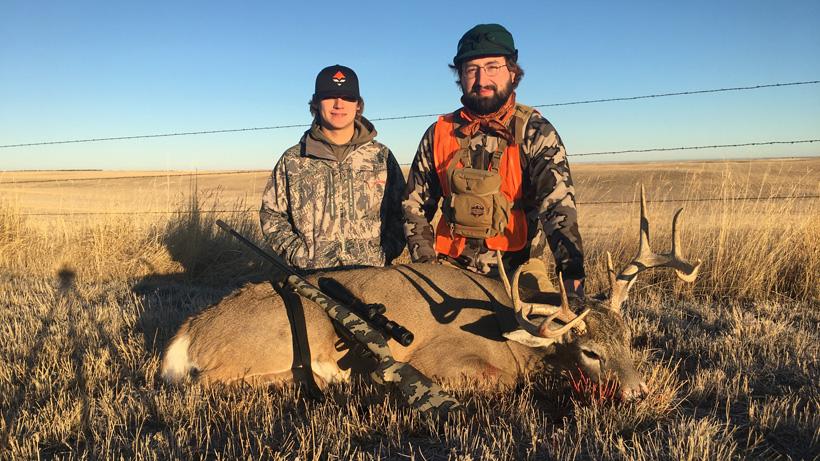
Chase Thompson and Colton Bender with Chase's 2018 Montana whitetail deer.
While Montana isn’t as well known for it’s trophy mule deer as some of the heavier hitting states like Arizona, Utah and Wyoming, it does offer some great hunting and even offers hunting during the rut on the general tag! Hunters can hunt nearly statewide on the general tag and several limited entry opportunities exist for mule deer, which can offer hunters great chances at bucks over the 180” mark. In fact, a few deer are killed every year that exceed 200”. The sheer amount of public land available in Montana gives hunters plenty of choices when it comes to terrain and the country they’d like to hunt in.
Most general units will provide good opportunities for mule deer bucks in the 140” to 150” Boone & Crockett (B&C) range; however, with effort and research, it’s not uncommon for hunters to bring home deer that eclipse the 170” mark. Whitetail hunting is great throughout the state with general trophy potentials ranging from 125” to 150” on up.
Note: The application deadline for Montana deer and elk is March 15, 2019 and can be mailed in or completed online here. Also, according to FWP, the online licensing system goes down every night from roughly midnight to 5:00 a.m. To ensure an application or purchase is entered on time, transactions should be completed by 11:45 p.m. Mountain Daylight Time.
Montana is comprised of nearly 30 million acres of public land with an additional 7.3 million acres of private land that are enrolled in Montana’s Block Management program. Learn more about the Block Management program here.
The general tag can be used nearly statewide for both whitetail and mule deer with several of the limited entry hunts for mule deer being guaranteed draws with 100% odds!
Along with an incredible general tag, Montana also offers some of the most generous season dates with six weeks of archery and five weeks of rifle hunting available on the same tag. Some tags even allow hunting with short-range weapons until Jan. 15!
Montana does not make hunters choose their selection of weapon and, instead, allows general tag and most permit holders to hunt every available season on just one tag!
As stated earlier, Montana is not known for producing giant bucks year after year; however, it does offer consistently good hunting.
In response to recent chronic wasting disease (CWD) outbreaks and concerns Montana Fish, Wildlife & Parks (FWP) has made several recommendations for changes in the 2019 season:
Montana is moving to an online-only application process by the license year 2020.
New for Filtering is the ability to filter Montana hunt districts based on the number of bucks or bulls harvested in the previous season. Montana has long been lacking in its data gathering and reporting and this is a huge feature GOHUNT has implemented to better help INSIDERS discover hidden gem areas. Once you dive into this data, you can then look at the number of "Hunters Surveyed" in the Unit Profiles to find the ideal hunt district that may have a high number of bulls harvested, and low hunting pressure.
In 2018, GOHUNT added Draw Odds for all female species. In Montana, there are many opportunities available for both whitetail and mule deer in the way of B licenses, which can be used in addition to your general tag! When selecting your districts to hunt be sure to also check out our Draw Odds details page to see if a few opportunities exist that can be added to your hunt.
View important information and an overview of the Montana rules/regulations, the draw system and bonus points, SuperTags, tag and license fees and an interactive boundary line map on our State Profile. You can also view the Montana Deer Profile to access historical and statistical data to help you find trophy areas.
* No archery season in HD 316
It is important for hunters to understand that any deer or elk permit obtained does not allow the taking of a second animal. Rather, it grants the ability to hunt bucks and bulls with the use of your general tag in a restricted hunting district. In Montana, hunters who possess a mule deer permit are not allowed to hunt mule deer in any other hunting district in the state regardless of the other hunting districts being limited entry or general. The opposite happens when you draw a special draw elk permit. For example, if you draw a special draw elk permit, you can still hunt all of the general districts plus that special draw district (during the season you drew the tag for).
Residents
Nonresidents
When submitting their initial applications, nonresidents will have a few options. First, they must apply for their choice of nonresident combination licenses as a prerequisite. All of the nonresident combination licenses include an upland game bird license, fishing license and bow and arrow license as well as the base hunting and conservation license. Successfully drawing any of the combination licenses will give successful applicants access to the statewide general tag.
While applying for their combination license, nonresidents will also be able to apply for limited entry permits if desired. The following table includes fees that will be tacked on top of your initial application fee for either the big game or elk combination license.
Applicants also have a few choices after the draw, depending on their plans for the fall. If an applicant was successful in drawing the elk or big game combination license, but unsuccessful in drawing a limited entry permit, they can request a refund of 80% of the combination license cost. Additionally, if an applicant successfully drew the big game permit, but only wishes to hunt deer with the general tag, they can request a refund of $323 for the elk license portion of the big game combination.
Grizzlies have been a hot topic of discussion, heated debates and emotional responses throughout the West. Hunts were approved in Wyoming and Idaho after grizzlies in the Greater Yellowstone Ecosystem (GYE) were removed from the Endangered Species Act (ESA) in 2017 by the U.S. Fish & Wildlife Service. Unfortunately, a federal judge reinstated ESA protections for grizzlies in September of 2018, effectively blocking the impending hunts scheduled to begin later in the fall.
All political agendas aside, the grizzly bear population in both the GYE and North Continental Divide Ecosystem have recovered to levels higher than originally planned for and interactions between bears and humans—mostly hunters—has been on a sharp rise. Hunters are becoming very concerned—and notably so. If you hunting in grizzly country in Montana be prepared to protect yourself and take all of the proper precautions to reduce to chances of encountering bears.
More information on bear safety can be found here.
2019 Montana snow water equivalent update as of February 17, 2019. Source: National Resources Conservation Service
2018 Montana snow water equivalent update as of February 16, 2018. Source: National Resources Conservation Service
Source: Montana Fish, Wildlife and Parks
Montana had a notable outbreak of CWD last year in populations of mule deer in the southern and north-central portions of the state. The state has established an aggressive containment program and have been actively working with landowners and hunters alike to slow the spread of the disease at all costs. So far, efforts have been largely successful, especially considering how contagious the disease is. Currently, there have not been any elk that have tested positive for CWD, but the concern is always there.
Before delving into the trending units for Montana deer in 2019, it is first important for hopeful applicants to fully understand the Montana draw system, which can, at times, be very complicated. For the main limited entry permit draws Montana employs a random lottery that is weighted by bonus points. Additionally, bonus points are squared at every point level. This system heavily favors those with the most points, but every applicant at every point level has a chance of drawing a tag every year. The bottom line here is you’ll never draw if you never apply.
The prerequisite for all nonresidents in Montana will be the Big Game, Elk or Deer Combination license. The combination licenses essentially act as a general tag for Montana and must be drawn. Unlike limited entry permits, the combination licenses are distributed through a preference point system where the highest point holders will receive licenses first. The first few years of this system saw 100% draw odds and, even, leftover tags. Last year, the combination licenses were drawn out in the initial draw, leaving hopeful hunters hanging by a thread and waiting for someone to turn a tag back in. Applicants with zero points stand about a 50% chance of drawing while those with one preference point will see 100% odds of drawing.
Elk Combination License includes the following:
Big Game Combination License includes the following:
Deer Combination License includes the following:
Montana grants nonresidents up to 10% of a district’s tag quota, but that 10% is not guaranteed. Some years, the nonresident applicant pool will fill the entire 10% cap and other years it can be significantly less.
Past general tags and nonresident combination hunters can apply for limited entry permits. Successfully drawing a limited entry permit does not grant a second animal, but does augment the general tag to include new areas for hunters. These limited entry units generally carry higher success rates and more mature animals; however, this is not always the case. MTFWP also uses some limited entry units as population control tools where they offer unlimited permits in hopes that the area will see a higher harvest for the year. Out of all of the limited entry units for deer and elk, less than half actually offer better odds at trophy animals than some of the better general hunts.
In addition to individual applications, hunters can also apply for deer and elk permits as a party. The maximum party size is five. The maximum party size is five. For example: the base bonus points for a party are the average of their individual base bonus points rounded to the nearest whole number. So if a party of three people has a total of 8 points, you would divide 8 by 3 = 2.67 which would round up to 3. When used correctly, party applications can be very beneficial. Residents and nonresidents can apply jointly; however the party will be forced into the 10% pool for available permits.
If applicants are simply looking to build points for the current year—both preference and bonus—they can skip the expensive application prerequisites. Bonus points can be purchased between July 1 and Sept. 30 for $15 per species for residents and $25 for nonresidents. Moose, bighorn sheep and mountain goat points can be purchased at the time for $75 per species. Additionally, nonresidents can purchase combination license preference points during the same time frame for $50. You cannot apply for a permit or combination license and purchase a separate point in the same year. Only one point per species can be accumulated per year.
Dylan Downson with his 2018 Montana mule deer.
As stated earlier, Montana generally doesn’t knock too many balls out of the park when it comes to mule deer trophy potential; however, the Big Sky State has been trending up over the last few years for big bucks. Most of the general units offer opportunities at great representations of mature deer in the 140” to 150” range. Some of the better general units will routinely kick out a 180”+ or two per year. Most of the limited entry units provide marginally better odds over the general tag though a few can produce the buck of a lifetime.
Source: Montana Fish, Wildlife and Parks
Like most states in the northwest US, Montana’s mule deer population has been dropping in overall numbers for the last decade. However, populations in Montana have seen a slight improvement with the total population growing by 13% since 2015. Hunters and biologists alike are keeping close tabs on the current CWD outbreak in Montana. Fortunately, the effects have been minimal up to this point. The 2018/2019 winter has been fairly mild with some late winter storms that have been moving into the western edge of the state. Overall, herds are expected to winter fine and experience good fawn recruitment for 2019.
To see a region by region population breakdown of Montana mule deer with graphics, visit our Species Profile for Montana mule deer below.
Montana Mule Deer Species Profile
When reporting on data for harvest surveys MFWP provides only the number of deer hunters; it does not differentiate between mule deer hunters and whitetail hunters. Because of this, showing accurate harvest success rates by individual deer species is impossible without it being largely skewed.
Josh Volinkaty with his 2018 Montana mule deer.
With Montana’s complicated two-part application process for limited entry tags many hunters may begin asking themselves if it’s really worth applying for limited entry tags here. The quick answer? Yes. The long answer? Don’t overlook any of the general units while putting together your plan for Montana. With the state’s lottery draw system, every applicant at every point level always has an opportunity to pull a tag of their choice. In the following section, we breakdown the top units for both the general tag as well as limited entry permits.
Like we’ve stated earlier, Montana definitely isn’t going to be a trophy destination for most hunters, but it does provide some excellent opportunities on general hunts as noted above. While most of the limited entry tags carry steep odds, there are some good sleeper units to consider if you’re simply looking to add more tags to your pocket.
*This was a new standalone hunt for the 2018 season. Because MTFWP has not yet released 2018 data we do not have any hunt specifics to share at this time.
MTFWP only reports hunter numbers for deer as a whole instead of differentiating between mule deer and whitetail. This unfortunate way of data representation has been the norm in Montana for some time and can make accurate data hard to come by for certain years. Currently, only data from the 2017 season is available and it is unclear at this point if more accurate numbers will be represented for the 2018 season. Beyond the current lack of data, MFWP groups all hunters together on the same report regardless of type of tag or type of weapon, which makes for very lackluster results when researching units.
At first glance, many hunters may question the decision to even apply for a special permit when so many general districts can produce bucks with the same trophy potentials. While this may be true, many of permit areas possess a much higher percentage of bucks classified as four points or better. What this equates to is a much higher potential of encountering bucks at the top of the trophy potential for a given district. Also, while unpublished, many of these permit areas also hold a much higher buck:doe ratio than most general hunt districts.
It is interesting to note that in 2018, several of the “best” hunt districts in the state for mule deer like 261, 262, 270 offered zero nonresidents tags. Based on Montana's up to 10% of tag allocation, this can happen, but it does seem odd that the top three districts all gave out zero permits in the same year.
When considering Montana as part of your western application strategy it is also important to note that the state is managed for opportunity with only a handful of areas actually being managed for trophy quality. Generally speaking, some of the best deer will only be accessible to high point holders and, even then, odds can be steep. There are some great permits to be drawn in Montana, but many of the general hunts can also provide excellent hunts.
Calvin Connor with his 2018 general season Montana mule deer.
While most of the state's biggest bucks are found in the top shelf draw districts, many hunters can find great success and trophy bucks in some of the general districts year after year while they accumulate points. Utilize our Filtering 2.0 tool and manipulate the Trophy Potential to display the districts that have a legitimate chance at bucks that score 160” or better. Customize your search and click on a specific district to access the Unit Profile in order to gain the greatest resource available to thoroughly learn an area. Our Montana Mule Deer Species Profile is another great way to determine other districts and regions of the state to consider. Within the Species Profile, you will find a table showing the top B&C producing districts over the years for both typical and nontypical bucks
Hunt Districts listed below may not have a current hunt for this species. Hunt Districts in this table are included if any part of the district is found within the county. Data provided below courtesy of the Boone and Crockett Club.
Before beginning your application strategy, it will be important to first decide your end goal for Montana. Mainly, do you plan on hunting Montana on general tags or are you only interested in building points to use later? As a nonresident, applicants will need to apply for their combo license in addition to any extra permits. If you are unsuccessful in the draw, you are only granted an 80% refund of your total application cost if you are not interested in hunting the general districts. If you wish to hunt other states, you can simply purchase the preference point and bonus point separately after July 1 and move on. If you do plan on hunting the general season regardless, then put in for your district of choice. Because it’s a lottery system, there is always a chance of drawing!
Montana can be a daunting state to build points in simply because it lacks a good supply of limited entry hunts. Applicants are either forced to cash out early on some of decent permits or hang on for dear life and hope that they pull the tag of their dreams in the next 20 years. Yet, it’s cheap to build points in Montana and the random draw gives everyone a small chance of drawing at any point. Don’t let the grave odds of drawing some of the better units deter your mind from the fact that Montana can hang with the best of them when it comes to its general tags and some incredible bucks are taken off general hunts every year.
With Montana nonresident combos finally selling out in the initial draw for 2017 it’s time for hunters to start considering the preference point system. Montana utilizes bonus points for license and permit drawings, but employs preference points for the nonresident combos (prerequisite for permits). Under the preference point system the highest point holders will draw the first 75% of the tags. Once that is finished remaining tags will move onto the remaining applicants. Last year applicants saw a 95% success rate in the nonresident drawings and should still see odds above 85% for the coming season. If you plan on making Montana part of your regular routine it would be a great move to start participating in the preference point system.
Coming into the 2018 drawings anyone holding one preference point or higher should draw their combo license without any problem. With the Montana preference point system you have to apply at least every other year or your accumulated preference points will be forfeited. With this system still being new it will be a few years before we see applicants with more than two points; however, point creep is going to become a huge issue very fast. If you are not planning on hunting Montana this year, but wish too in the next two years, it would be very smart to buy a preference point for 2018 to stay ahead of this creep.
2019 max bonus points for deer: 15
Residents
At zero points, your options are going to be very limited in drawing tags. Some districts can be drawn with unlimited quotas and a 100% chance of drawing, but these will generally have very low trophy potentials and are merely used as management tools. Consider hunting general districts while applying for your desired district. With the lottery system you always have a slim chance of drawing.
Nonresidents
As with residents, many districts with an unlimited quota can be drawn with 100% odds. Consider hunting general districts while applying for your desired district. With the lottery system you always have a slim chance of drawing.
With three to four points both residents and nonresidents will see very few additional districts (compared to those with zero to two points). However, nonresidents will now see a few more districts available with 100% odds, which can be an attractive use of points.
Residents
If you are holding out for some of the top tier districts keep applying for these and play your odds in the lottery as you continue to build points. General districts can still provide good opportunities at bucks above the 160” mark.
Nonresidents
If you are holding out for some of the top tier districts keep applying for these and play your odds in the lottery as you continue to build points. General districts can still provide opportunities at bucks above the 160” mark.
At this point level, residents and nonresidents are nearing the maximum point capacity. Applying for anything other than the top tier districts will merely result in burning points on hunting districts that could be drawn on far less. Odds will still be steep, but your odds simply won’t improve beyond this point with Montana’s drawing system.
Residents
Residents may tire of continually applying for the best districts in the state and not being rewarded for having maximum points. Aside from continuing to apply for HDs 261 and 270 there are a few standout districts that can provide opportunities at bucks above the 160”+ mark including HDs 210, 250, 291, 312, 441 and 652.
Nonresidents
As with the residents, nonresidents are now nearing the maximum point level and really have their hands tied with districts to burn their precious points on. HDs 261 and 270 will still provide the best bucks, but HDs 210, 250, 291, 312, 441 and 652 can be good backups to consider.
Rex Wolferman with his 2018 Montana archery whitetail deer.
Along with some great mule deer hunting opportunities, Montana has a ton to offer for whitetail hunting. Every unit in the state can be hunted in the general tag plus there are several either-sex B licenses available throughout the state that allow for a second buck to be taken in the same year! Overall, trophy qualities are great throughout the state and there's a plethora of terrain variances for hunters to choose from.
Source: Montana Fish, Wildlife and Parks
As in most locations, whitetail populations are thriving in Montana. CWD has continued to be a concern in some areas though the disease has mostly impacted mule deer herds up to this point. The 2018/2019 winter is looking to be fairly moderate—even with recent snow storms—and we should see some great antler growth throughout the spring and early summer months. Anyone with Montana whitetail on their radar for 2019 will be in for a great hunt!
To see a region by region breakdown of Montana whitetail deer with graphics, visit our Species Profile for Montana whitetail deer below.
Brad Heine with his 2018 Montana archery whitetail deer.
As stated before, there are some draw opportunities for whitetail though these are generally extra either-sex licenses that won’t open any new areas, but do allow the killing of a second buck. Essentially, the general tag is good statewide and good hunting can be found in nearly every district. With so much opportunity, the biggest struggle for most will be, ultimately, deciding on where to go. In the following list, we breakdown some of the top units found in the Big Sky State.
MFWP only reports hunter numbers for deer as a whole instead of differentiating between mule deer and whitetail. This unfortunate way of data representation has been the norm in Montana for some time and can make accurate data hard to come by during certain years. Currently, only data from the 2017 season is available and it is unclear at this point if more accurate numbers will be represented for the 2018 season. Beyond the current lack of data, MFWP groups all hunters together on the same report regardless of type of tag or type of weapon, which makes for very lackluster results when researching units.
Chase Thompson and Colton Bender with Chase's 2018 Montana whitetail deer.
As stated before, finding sleeper units for Montana whitetail can be tough due to the sheer number of huntable districts. Utilize our Filtering 2.0 tool and manipulate the Trophy Potential to display the districts that have a legitimate chance at bucks that score 120” or better. Customize your search and click on a specific district to access the Unit Profile in order to gain the greatest resource available to thoroughly learn an area. Our Montana Whitetail Species Profile is another great way to determine other districts and regions of the state to consider. Within the Species Profile you will find a table showing the top B&C producing districts over the years for both typical and nontypical bucks.
Hunt Districts listed below may not have a current hunt for this species. Hunt Districts in this table are included if any part of the district is found within the county. Data provided below courtesy of the Boone and Crockett Club.
When looking at limited entry hunt districts for Montana whitetail hunters can quickly become confused. First, there are only two hunt districts in the state that offers drawings for permits (HD 290 and HD 455). A permit allows a hunter to augment their already existing general tag. In other words, a permit only allows you to hunt a new unit, but does not add an additional tag to your pocket. Hunters can also participate in drawings for B licenses which allow the taking of additional deer. Pay close attention to the regulations as some of the B license are listed as either sex and will allow a hunter to kill up to two bucks in a year.
Because Montana whitetail hunting is done almost entirely on the general tag there really isn’t any real application strategies to be had. Still, deer points are good for both whitetail and mule deer and building points is inexpensive when already applying for a combination tag.
With Montana nonresident combos finally selling out in the initial draw for 2017 it’s time for hunters to start considering the preference point system. Montana utilizes bonus points for license and permit drawings, but employs preference points for the nonresident combos (prerequisite for permits). Under the preference point system, the highest point holders will draw the first 75% of the tags. Once that is finished, remaining tags will move onto the remaining applicants. Last year applicants saw a 95% success rate in the nonresident drawings and should still see odds above 85% for the coming season. If you plan on making Montana part of your regular routine it would be a great move to start participating in the preference point system.
Note: this is the same big game combo as mule deer.
Coming into the 2018 drawings anyone holding one preference point or higher should draw their combo license without any problem. With the Montana preference point system you have to apply at least every other year or your accumulated preference points be forfeited. With this system still being new it will be a few years before we see applicants with more than two points; however, point creep is going to become a huge issue very fast. If you are not planning on hunting Montana this year, but wish too in the next two years, it would be very smart to buy a preference point for 2018 to stay ahead of this creep.
Really, there isn’t much of a strategy when it comes to points for whitetail in Montana. The two hunt districts (HD 290 and HD 455) available to draw boast great statistics but still offer little more than some of the better general districts. Since Montana does not differentiate points between whitetail and mule deer permits you would be better off to build your points towards a premium mule deer permit.
2019 resident deer and elk permit application packet
2019 nonresident combination license and deer and elk permit application packet
HD 502: change the general mule deer season from buck-only to either-sex.
HD 510: eliminate the unlimited 510-50 buck mule deer permit and establish an either-sex mule deer season.
HD 520: change the general mule deer season from buck only to either-sex in that portion of HD 520 lying east of Highway 212.
HD 575: increase 575-00 antlerless mule deer B licenses from 250 to 500 and increase the biennial range from 5-200 to 5-750. This proposal is outside the current biennial range and requires commission action.
Applications for deer and elk must be submitted by 11:59 p.m. MST on March 15.
Applications can be submitted by mail or online here.
An 80% refund can be requested on nonresident licenses if requested by Aug. 1, 2019.
A 50% refund can be requested on nonresident licenses if requested after Aug. 1, 2019.
Draw results are generally available mid-April.
Surplus licenses are available for purchase on Aug. 7, 2019.
Preference and bonus points are available for purchase for nonresidents who did not apply in the general drawing between July 1 and Sept. 30 for a fee.
Elk, conservation license, state lands, upland bird (excluding turkey), Base Hunting, AISPP and season fishing license.
Deer, elk, conservation license, state lands, upland bird (excluding turkey), Base Hunting, AISPP and season fishing license.
Deer, conservation, state lands, upland bird (excluding turkey), base hunting, AISPP and season fishing license.
HuntDistrict | |
|---|---|
TrophyPotential | 170"+ |
Totalharvest | 905 |
% 4pt orbetter | 67% |
Bucksharvested | 855 |
Public land% | 47% |
HuntDistrict | |
TrophyPotential | 170"+ |
Totalharvest | 100 |
% 4pt orbetter | 61% |
Bucksharvested | 92 |
Public land% | 86% |
HuntDistrict | |
TrophyPotential | 170"+ |
Totalharvest | 330 |
% 4pt orbetter | 57% |
Bucksharvested | 260 |
Public land% | 12% |
HuntDistrict | |
TrophyPotential | 170"+ |
Totalharvest | 2,279 |
% 4pt orbetter | 69% |
Bucksharvested | 1,485 |
Public land% | 18% |
HuntDistrict | |
TrophyPotential | 170"+ |
Totalharvest | 1,595 |
% 4pt orbetter | 73% |
Bucksharvested | 1,148 |
Public land% | 12% |
HuntDistrict | |
TrophyPotential | 170"+ |
Totalharvest | 3,512 |
% 4pt orbetter | 73% |
Bucksharvested | 459 |
Public land% | 31% |
HuntDistrict | |
TrophyPotential | 170"+ |
Totalharvest | 835 |
% 4pt orbetter | 72% |
Bucksharvested | 2,555 |
Public land% | 30% |
HuntDistrict | |
TrophyPotential | 160"+ |
Totalharvest | 525 |
% 4pt orbetter | 73% |
Bucksharvested | 493 |
Public land% | 16% |
HuntDistrict | 680 |
TrophyPotential | 160"+ |
Totalharvest | 599 |
% 4pt orbetter | 78% |
Bucksharvested | 399 |
Public land% | 40% |
HuntDistrict | |
TrophyPotential | 160"+ |
Totalharvest | 2,894 |
% 4pt orbetter | 68% |
Bucksharvested | 866 |
Public land% | 36% |
HuntDistrict | |
TrophyPotential | 160"+ |
Totalharvest | 2,882 |
% 4pt orbetter | 71% |
Bucksharvested | 1,669 |
Public land% | 16% |
HuntDistrict | TrophyPotential | Totalharvest | % 4pt orbetter | Bucksharvested | Public land% |
|---|---|---|---|---|---|
170"+ | 905 | 67% | 855 | 47% | |
170"+ | 100 | 61% | 92 | 86% | |
170"+ | 330 | 57% | 260 | 12% | |
170"+ | 2,279 | 69% | 1,485 | 18% | |
170"+ | 1,595 | 73% | 1,148 | 12% | |
170"+ | 3,512 | 73% | 459 | 31% | |
170"+ | 835 | 72% | 2,555 | 30% | |
160"+ | 525 | 73% | 493 | 16% | |
680 | 160"+ | 599 | 78% | 399 | 40% |
160"+ | 2,894 | 68% | 866 | 36% | |
160"+ | 2,882 | 71% | 1,669 | 16% |
Hunt District | |
|---|---|
# of bucksharvested | 924 |
Hunt District | |
# of bucksharvested | 883 |
Hunt District | |
# of bucksharvested | 788 |
Hunt District | HD 102 |
# of bucksharvested | 700 |
Hunt District | |
# of bucksharvested | 694 |
Hunt District | |
# of bucksharvested | 668 |
Hunt District | |
# of bucksharvested | 641 |
Hunt District | |
# of bucksharvested | 626 |
Hunt District | |
# of bucksharvested | 599 |
Hunt District | |
# of bucksharvested | 566 |
HuntDistrict | |
|---|---|
TrophyPotential | 180"+ |
Totalharvest | 42 |
% 4pt orbetter | 88% |
Bucksharvested | 26 |
Public land% | 60% |
HuntDistrict | 262* |
TrophyPotential | 180"+ |
Totalharvest | NA |
% 4pt orbetter | NA |
Bucksharvested | NA |
Public land% | 2% |
HuntDistrict | |
TrophyPotential | 180"+ |
Totalharvest | 49 |
% 4pt orbetter | 84% |
Bucksharvested | 49 |
Public land% | 85% |
HuntDistrict | |
TrophyPotential | 170"+ |
Totalharvest | 62 |
% 4pt orbetter | 74% |
Bucksharvested | 62 |
Public land% | 20% |
HuntDistrict | 300 |
TrophyPotential | 170"+ |
Totalharvest | 104 |
% 4pt orbetter | 33% |
Bucksharvested | 83 |
Public land% | 74% |
HuntDistrict | |
TrophyPotential | 160"+ |
Totalharvest | 81 |
% 4pt orbetter | 58% |
Bucksharvested | 78 |
Public land% | 94% |
HuntDistrict | |
TrophyPotential | 160"+ |
Totalharvest | 50 |
% 4pt orbetter | 58% |
Bucksharvested | 48 |
Public land% | 42% |
HuntDistrict | |
TrophyPotential | 160"+ |
Totalharvest | 50 |
% 4pt orbetter | 58% |
Bucksharvested | 48 |
Public land% | 42% |
HuntDistrict | |
TrophyPotential | 160"+ |
Totalharvest | 182 |
% 4pt orbetter | 56% |
Bucksharvested | 149 |
Public land% | 50% |
HuntDistrict | |
TrophyPotential | 160"+ |
Totalharvest | 122 |
% 4pt orbetter | 71% |
Bucksharvested | 113 |
Public land% | 39% |
HuntDistrict | |
TrophyPotential | 160"+ |
Totalharvest | 62 |
% 4pt orbetter | 92% |
Bucksharvested | 62 |
Public land% | 61% |
County | Lake |
|---|---|
No. ofentries | 1 |
Hunt Districts found within county | |
County | Park |
No. ofentries | 1 |
Hunt Districts found within county | |
County | Powder |
No. ofentries | 1 |
Hunt Districts found within county | |
County | Sheridan |
No. ofentries | 1 |
Hunt Districts found within county | 640 / 641 |
Hunt District | |
|---|---|
# of bucksharvested | 2,555 |
Hunt District | |
# of bucksharvested | 2,459 |
Hunt District | |
# of bucksharvested | 1,866 |
Hunt District | |
# of bucksharvested | 1,669 |
Hunt District | |
# of bucksharvested | 1,485 |
Hunt District | |
# of bucksharvested | 1,366 |
Hunt District | |
# of bucksharvested | 1,219 |
Hunt District | |
# of bucksharvested | 1,148 |
Hunt District | |
# of bucksharvested | 1,067 |
Hunt District | HD 500 |
# of bucksharvested | 858 |
Hunt District | HD 132 |
|---|---|
TrophyPotential | 150"+ |
Totalharvest | 491 |
% 4pt orbetter | 68% |
Bucksharvested | 348 |
Public land% | 53.6% |
Hunt District | HD 102 |
TrophyPotential | 140"+ |
Totalharvest | 916 |
% 4pt orbetter | 58% |
Bucksharvested | 700 |
Public land% | 63.5% |
Hunt District | |
TrophyPotential | 140"+ |
Totalharvest | 420 |
% 4pt orbetter | 56% |
Bucksharvested | 309 |
Public land% | 77.2% |
Hunt District | |
TrophyPotential | 140"+ |
Totalharvest | 1,024 |
% 4pt orbetter | 61% |
Bucksharvested | 694 |
Public land% | 82.6% |
Hunt District | |
TrophyPotential | 140"+ |
Totalharvest | 244 |
% 4pt orbetter | 60% |
Bucksharvested | 195 |
Public land% | 89.4% |
Hunt District | |
TrophyPotential | 140"+ |
Totalharvest | 189 |
% 4pt orbetter | 65% |
Bucksharvested | 126 |
Public land% | 64% |
Hunt District | |
TrophyPotential | 140"+ |
Totalharvest | 803 |
% 4pt orbetter | 52% |
Bucksharvested | 641 |
Public land% | 89.8% |
Hunt District | |
TrophyPotential | 140"+ |
Totalharvest | 192 |
% 4pt orbetter | 53% |
Bucksharvested | 177 |
Public land% | 89.2% |
Hunt District | |
TrophyPotential | 140"+ |
Totalharvest | 525 |
% 4pt orbetter | 51% |
Bucksharvested | 457 |
Public land% | 78% |
Hunt District | |
TrophyPotential | 140"+ |
Totalharvest | 225 |
% 4pt orbetter | 51% |
Bucksharvested | 171 |
Public land% | 65% |
Hunt District | |
TrophyPotential | 140"+ |
Totalharvest | 738 |
% 4pt orbetter | 54% |
Bucksharvested | 566 |
Public land% | 70.9% |
Hunt District | |
TrophyPotential | 140"+ |
Totalharvest | 22 |
% 4pt orbetter | 100% |
Bucksharvested | 20 |
Public land% | 99% |
Hunt District | |
TrophyPotential | 140"+ |
Totalharvest | 277 |
% 4pt orbetter | 93% |
Bucksharvested | 137 |
Public land% | 62% |
Hunt District | TrophyPotential | Totalharvest | % 4pt orbetter | Bucksharvested | Public land% |
|---|---|---|---|---|---|
HD 132 | 150"+ | 491 | 68% | 348 | 53.6% |
HD 102 | 140"+ | 916 | 58% | 700 | 63.5% |
140"+ | 420 | 56% | 309 | 77.2% | |
140"+ | 1,024 | 61% | 694 | 82.6% | |
140"+ | 244 | 60% | 195 | 89.4% | |
140"+ | 189 | 65% | 126 | 64% | |
140"+ | 803 | 52% | 641 | 89.8% | |
140"+ | 192 | 53% | 177 | 89.2% | |
140"+ | 525 | 51% | 457 | 78% | |
140"+ | 225 | 51% | 171 | 65% | |
140"+ | 738 | 54% | 566 | 70.9% | |
140"+ | 22 | 100% | 20 | 99% | |
140"+ | 277 | 93% | 137 | 62% |
County | Ravalli |
|---|---|
No. ofentries | 7 |
Hunt Districts found within county | |
County | Pondera |
No. ofentries | 3 |
Hunt Districts found within county | |
County | Rosebud |
No. ofentries | 2 |
Hunt Districts found within county | |
County | Cascade |
No. ofentries | 1 |
Hunt Districts found within county | |
County | Dawson |
No. ofentries | 1 |
Hunt Districts found within county | 651 / 703 |
County | Sheridan |
No. ofentries | 1 |
Hunt Districts found within county | 640 / 641 |
County | Toole |
No. ofentries | 1 |
Hunt Districts found within county |
County | Chouteau |
|---|---|
No. ofentries | 1 |
Hunt Districts found within county | |
County | Flathead |
No. ofentries | 1 |
Hunt Districts found within county | 101 / 102 / 103 / 110 / 120 / 122 / 132 / 140 / 141 / 150 / 151 / 170 |
County | Toole |
No. ofentries | 1 |
Hunt Districts found within county | |
County | Lake |
No. ofentries | 1 |
Hunt Districts found within county | |
County | Gallatin |
No. ofentries | 1 |
Hunt Districts found within county | 301 / 309 / 310 / 311 / 312 / 314 / 333 / 361 / 362 / 390 / 393 |
County | Sanders |
No. ofentries | 1 |
Hunt Districts found within county | |
County | Powder River |
No. ofentries | 1 |
Hunt Districts found within county |